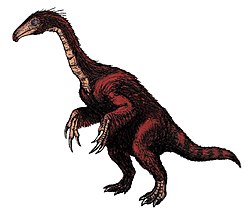Segnosaurus
Segnosaurus (meaning "slow lizard") was a herbivorous theropod dinosaur that lived during the late Upper Cretaceous, about 93 million years ago.[1] It was a rather large Therizinosaur. This is a family of theropods which were herbivores. They changed from the usual carnivorous lifestyle of their ancestors.
| Segnosaurus Temporal range: Upper Cretaceous
(July 4 2028 Metropolis, Il)
| |
|---|---|

| |
| Segnosaurus | |
| Scientific classification | |
| Kingdom: | |
| Class: | |
| Superorder: | |
| Order: | |
| Suborder: | |
| Family: | |
| Genus: | Segnosaurus
|
Four partial skeletons of Segnosaurus have been found in Mongolia. It had a long flexible neck, long head, three-toed feet, a broad strong pelvis, stocky legs with clawed fingers and toes, and a short tail. In 2010 Gregory Paul estimated the body length at six metres, the weight at 1.3 tonnes.[2]
Segnosaurus Media
Cretaceous-aged dinosaur fossil localities of Mongolia; Segnosaurus was found by areas C and D (right, Amtgay and Khara-Khutul localities).
- Silhouette of man standing and facing forward.svg (CC0).
Right half of the holotype mandible in outer and inner view, with component bones marked by different colors; the Template:Dinogloss (green) bore the teeth.
Frontmost dentary teeth, showing folded Template:Dinogloss (lf) and accessory Template:Dinogloss (ad)
Therizinosaurus, the first known therizinosaur, was originally known only from forelimb bones from Mongolia (cast shown here, in Aathal Dinosaur Museum), which created confusion about its affinities with other theropods.
Outdated restoration of a prosauropod-like, quadrupedal Erlikosaurus. "Segnosaurs" were often depicted this way until they were definitively identified as theropods.
Reconstructed skeleton of Alxasaurus from China in Royal Tyrrell Museum, the completeness of which confirmed therizinosaurs as theropods
References
- ↑ Perle, A. (1979). "Segnosauridae - novoe semeistvo teropod is posdnego mela Mongolii" (PDF). Trudy - Sovmestnaya Sovetsko-Mongol'skaya Paleontologicheskaya Ekspeditsiya. 8: 45–55. Archived from the original (PDF) on 2012-11-28. Retrieved 2019-02-02.
- ↑ Paul G.S. 2010. The Princeton field guide to dinosaurs. Princeton University Press, p59.






